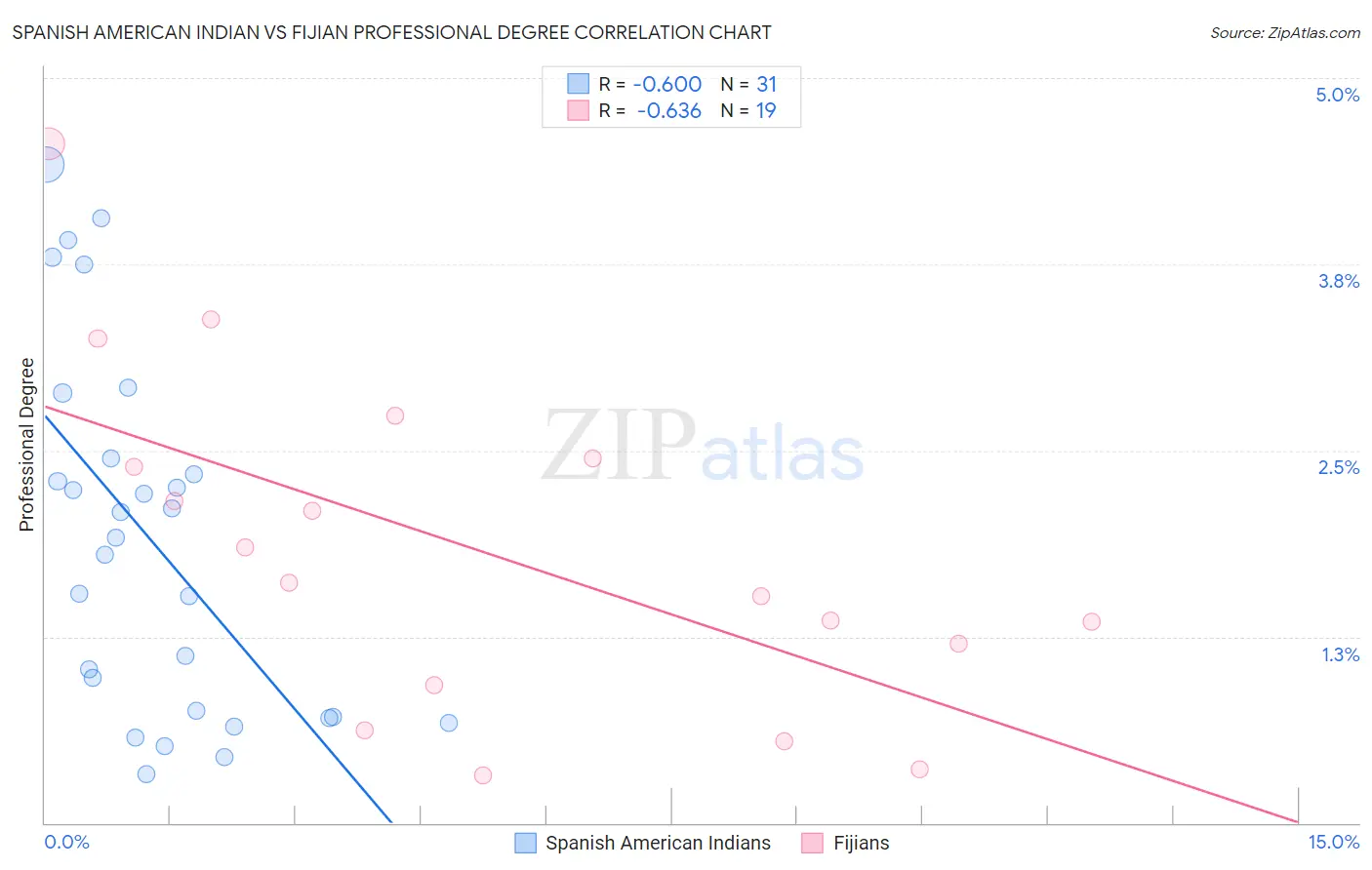Spanish American Indian vs Fijian Professional Degree
COMPARE
Spanish American Indian
Fijian
Professional Degree
Professional Degree Comparison
Spanish American Indians
Fijians
2.7%
PROFESSIONAL DEGREE
0.0/ 100
METRIC RATING
344th/ 347
METRIC RANK
2.9%
PROFESSIONAL DEGREE
0.0/ 100
METRIC RATING
336th/ 347
METRIC RANK
Spanish American Indian vs Fijian Professional Degree Correlation Chart
The statistical analysis conducted on geographies consisting of 73,088,569 people shows a significant negative correlation between the proportion of Spanish American Indians and percentage of population with at least professional degree education in the United States with a correlation coefficient (R) of -0.600 and weighted average of 2.7%. Similarly, the statistical analysis conducted on geographies consisting of 55,894,250 people shows a significant negative correlation between the proportion of Fijians and percentage of population with at least professional degree education in the United States with a correlation coefficient (R) of -0.636 and weighted average of 2.9%, a difference of 10.3%.

Professional Degree Correlation Summary
| Measurement | Spanish American Indian | Fijian |
| Minimum | 0.32% | 0.32% |
| Maximum | 4.4% | 4.6% |
| Range | 4.1% | 4.2% |
| Mean | 1.9% | 1.8% |
| Median | 1.9% | 1.6% |
| Interquartile 25% (IQ1) | 0.71% | 0.93% |
| Interquartile 75% (IQ3) | 2.4% | 2.4% |
| Interquartile Range (IQR) | 1.7% | 1.5% |
| Standard Deviation (Sample) | 1.2% | 1.1% |
| Standard Deviation (Population) | 1.2% | 1.1% |
Demographics Similar to Spanish American Indians and Fijians by Professional Degree
In terms of professional degree, the demographic groups most similar to Spanish American Indians are Immigrants from Mexico (2.6%, a difference of 0.32%), Mexican (2.7%, a difference of 3.6%), Immigrants from the Azores (2.8%, a difference of 6.6%), Tohono O'odham (2.8%, a difference of 7.3%), and Lumbee (2.5%, a difference of 7.7%). Similarly, the demographic groups most similar to Fijians are Native/Alaskan (3.0%, a difference of 1.0%), Pennsylvania German (3.0%, a difference of 1.6%), Arapaho (2.9%, a difference of 1.8%), Navajo (2.9%, a difference of 1.9%), and Immigrants from Central America (2.9%, a difference of 2.0%).
| Demographics | Rating | Rank | Professional Degree |
| Creek | 0.0 /100 | #328 | Tragic 3.1% |
| Bangladeshis | 0.0 /100 | #329 | Tragic 3.1% |
| Immigrants | Cabo Verde | 0.0 /100 | #330 | Tragic 3.1% |
| Kiowa | 0.0 /100 | #331 | Tragic 3.1% |
| Yakama | 0.0 /100 | #332 | Tragic 3.1% |
| Puget Sound Salish | 0.0 /100 | #333 | Tragic 3.1% |
| Pennsylvania Germans | 0.0 /100 | #334 | Tragic 3.0% |
| Natives/Alaskans | 0.0 /100 | #335 | Tragic 3.0% |
| Fijians | 0.0 /100 | #336 | Tragic 2.9% |
| Arapaho | 0.0 /100 | #337 | Tragic 2.9% |
| Navajo | 0.0 /100 | #338 | Tragic 2.9% |
| Immigrants | Central America | 0.0 /100 | #339 | Tragic 2.9% |
| Yup'ik | 0.0 /100 | #340 | Tragic 2.9% |
| Tohono O'odham | 0.0 /100 | #341 | Tragic 2.8% |
| Immigrants | Azores | 0.0 /100 | #342 | Tragic 2.8% |
| Mexicans | 0.0 /100 | #343 | Tragic 2.7% |
| Spanish American Indians | 0.0 /100 | #344 | Tragic 2.7% |
| Immigrants | Mexico | 0.0 /100 | #345 | Tragic 2.6% |
| Lumbee | 0.0 /100 | #346 | Tragic 2.5% |
| Houma | 0.0 /100 | #347 | Tragic 2.2% |